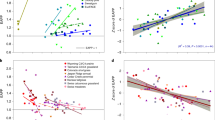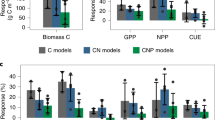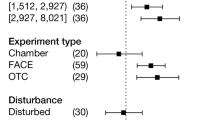Abstract
Arid ecosystems, which occupy about 20% of the earth's terrestrial surface area, have been predicted to be one of the most responsive ecosystem types to elevated atmospheric CO2 and associated global climate change1,2,3. Here we show, using free-air CO2 enrichment (FACE) technology in an intact Mojave Desert ecosystem4, that new shoot production of a dominant perennial shrub is doubled by a 50% increase in atmospheric CO2 concentration in a high rainfall year. However, elevated CO2 does not enhance production in a drought year. We also found that above-ground production and seed rain of an invasive annual grass increases more at elevated CO2 than in several species of native annuals. Consequently, elevated CO2 might enhance the long-term success and dominance of exotic annual grasses in the region. This shift in species composition in favour of exotic annual grasses, driven by global change, has the potential to accelerate the fire cycle, reduce biodiversity and alter ecosystem function in the deserts of western North America.
This is a preview of subscription content, access via your institution
Access options
Subscribe to this journal
Receive 51 print issues and online access
$199.00 per year
only $3.90 per issue
Buy this article
- Purchase on Springer Link
- Instant access to full article PDF
Prices may be subject to local taxes which are calculated during checkout


Similar content being viewed by others
References
Strain, B. R. & Bazzaz, F. A. in CO2 and Plants: The Response of Plants to Rising Levels of Carbon Dioxide (ed. Lemon, E.) 177–222 (AAAS, Washington DC, 1983).
Melillo, J. M. et al. Global climate change and terrestrial net primary production. Nature 363, 234–240 (1993).
Smith, S. D., Monson, R. K. & Anderson, J. E. Physiological Ecology of North American Desert Plants (Springer, Berlin, 1997).
Jordan, D. N. et al. Biotic, abiotic and performance aspects of the Nevada Desert Free-Air CO2 Enrichment (FACE) Facility. Global Change Biol. 5, 659–668 ( 1999).
Bazzaz, F. A. The response of natural ecosystems to rising global CO2 levels. Annu. Rev. Ecol. Syst. 21, 167– 196 (1990).
Smith, S. D., Strain, B. R. & Sharkey, T. D. Effects of CO2 enrichment on four Great Basin grasses. Funct. Ecol. 1, 139– 143 (1987).
Mayeux, H. S., Johnson, H. B. & Polley, H. W. in Ecology and Management of Annual Grasslands (eds Monsen, S. B. & Kitchen, S. G.) 95–100 (US Forest. Serv. Gen. Tech. Rep. INT-GTR-313, Ogden, Utah, USA, 1994).
Sage, R. F. in Carbon Dioxide, Populations and Communities (eds Körner, C. & Bazzaz, F. A.) 231–249 (Academic, San Diego, 1996).
Naeem, S., Thompson, L. J., Lawler, S. P., Lawton, J. H. & Woodfin, R. M. Declining biodiversity can alter the performance of ecosystems. Nature 368, 734–737 (1994).
Hendrey, G. R. & Kimball, B. A. The FACE program. Agric. For. Meteorol. 70, 3– 14 (1994).
Hunter, R. Bromus invasions on the Nevada Test Site: present status of B. rubens and B. tectorum with notes on their relationship to disturbance and altitude. Great Basin Nat. 51, 176– 182 (1991).
Schlesinger, W. H., Raikes, J. A., Hartley, A. E. & Cross, A. F. On the spatial pattern of soil nutrients in desert ecosystems. Ecology 77, 364–374 ( 1996).
Huxman, T. E., Hamerlynck, E. P. & Smith, S. D. Reproductive allocation and seed production in Bromus madritensis ssp. rubens at elevated CO2. Funct. Ecol. 13, 769–777 (2000).
Huxman, T. E. et al. The effects of parental CO2 on seed quality and subsequent seedling performance in Bromus rubens. Oecologia 114, 202–208 ( 1998).
Brown, J. H. & Heske, E. J. Control of a desert-grassland transition by a keystone rodent guild. Science 250, 1705–1707 (1990).
DeLucia, E. H. et al. Net primary production of a forest ecosystem with experimental CO2 enrichment. Science 284, 1177–1179 (1999).
Hamerlynck, E. P. et al. Photosynthetic responses of Larrea tridentata to a step-increase in atmospheric CO2 at the Nevada Desert FACE Facility. J. Arid Environ. 44, 425– 436 (2000).
Huxman, T. E. et al. Photosynthetic down-regulation in Larrea tridentata exposed to elevated atmospheric CO2: interaction with drought under glasshouse and field (FACE) exposure. Plant Cell Environ. 21, 1153–1161 (1998).
Noy-Meir, I. Desert ecosystems: environment and producers. Annu. Rev. Ecol. Syst. 4, 51–58 ( 1973).
Mack, R. N. The invasion of Bromus tectorum L. into western North America: an ecological chronicle. Agro-Ecosystems 7, 145– 165 (1981).
Knapp, P. A. Spatio-temporal patterns of large grassland fires in the Intermountain West, U.S.A. Global Ecol. Biogeogr. Lett. 7, 259 –272 (1998).
Young, J. A. & Evans, R. A. Population dynamics after wildfires in sagebrush grasslands. J. Range Manage. 31, 283–289 (1978).
Melgoza, G., Nowak, R. S. & Tausch, R. J. Soil water exploitation after fire: competition between Bromus tectorum (cheatgrass) and two native species. Oecologia 83, 7–13 (1990 ).
Acknowledgements
We thank D. Jordan, E. Knight, G. Hendrey and the Brookhaven National Laboratory for technical support; C. Biggart, L. DeFalco, C. Grant, E. Hamerlynck, M. Hargrove, K. Hightower, K. Huxman, F. Landau, D. Pataki, K. Salsman, T. Shiver, D. Stortz-Lintz, and M. Taub for field and laboratory assistance; and J. Titus for soil nitrogen data. Financial support was provided by the DOE- and NSF-EPSCoR programs and panel grants from NSF/TECO and DOE/TCP, and additional support was provided by the NAES. We also thank the DOE/Nevada Operations Office and Bechtel Nevada for site operations support.
Author information
Authors and Affiliations
Corresponding author
Rights and permissions
About this article
Cite this article
Smith, S., Huxman, T., Zitzer, S. et al. Elevated CO2 increases productivity and invasive species success in an arid ecosystem. Nature 408, 79–82 (2000). https://doi.org/10.1038/35040544
Received:
Accepted:
Issue Date:
DOI: https://doi.org/10.1038/35040544
This article is cited by
-
Mineral dust aerosol impacts on global climate and climate change
Nature Reviews Earth & Environment (2023)
-
Hormetic effects of abiotic environmental stressors in woody plants in the context of climate change
Journal of Forestry Research (2023)
-
Contrasting responses of woody and grassland ecosystems to increased CO2 as water supply varies
Nature Ecology & Evolution (2022)
-
Seedling responses to soil moisture amount versus pulse frequency in a successfully encroaching semi-arid shrub
Oecologia (2022)
-
Biodiversity conservation as a promising frontier for behavioural science
Nature Human Behaviour (2021)
Comments
By submitting a comment you agree to abide by our Terms and Community Guidelines. If you find something abusive or that does not comply with our terms or guidelines please flag it as inappropriate.



